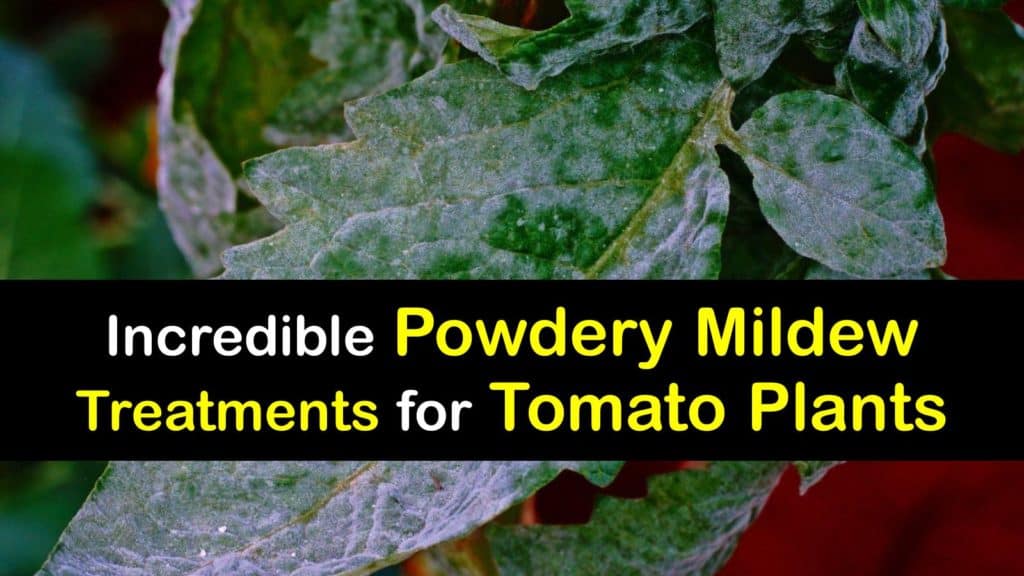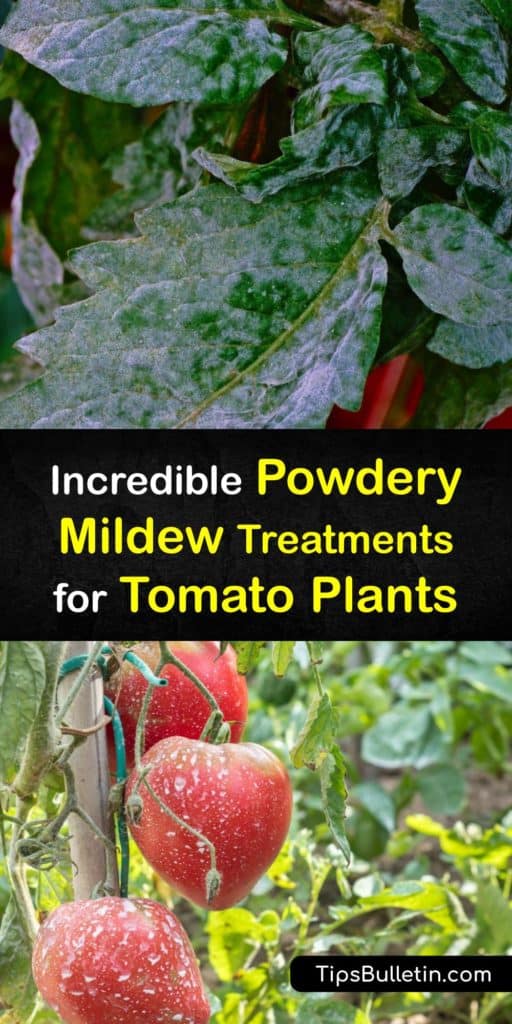Powdery mildew is a common fungus-based disease for plants like tomato and squash plants and cucurbit crops from different fungal species. Luckily for home gardeners, getting rid of powdery mildew on tomato plants is inexpensive and straightforward. Continue reading for tips on how to get rid of powdery mildew on tomatoes.
Powdery mildew is easy to identify on plants by the fuzzy gray mold or white powder that gathers on the leaves and stems of your plants. The mildew looks like powdered sugar dusted on the leaves.
Although the powdery mildew may look harmless, if left untreated, the mold causes the death of leaves, reduced yield, and low quality in fruit. Powdery mildew growth happens quickly in humid environments, but unlike downy mildew or late blight, powdery mildew doesn’t do well in damp areas.

Dealing with White Mildew on Tomato Leaves
Tomato powdery mildew infection starts on tomato plant leaves as pale yellow spots. These spots soon become covered with white spores. As the powdery mildew fungi advances, the leaf mold’s white parts turn brown and become brittle.
Once a plant in your garden is infected, powdery mildew spores are easily spread through the air or from contact with an infected plant. Fungal spores are also distributed from water droplets bouncing off an infected leaf or from unsanitized tools after working with affected plants.
A powdery mildew infection causes the leaf pores to become clogged, preventing light from reaching plant cells. As your tomato plant requires light as an energy source to grow, clogged pores cause your plant to become weakened, resulting in stunted growth.
Older leaves on the plant fall off as the fungus advances, and your tomato plant struggles to stay alive. Any fruit harvested from this plant lacks flavor. Tomato leaf mold is common on stressed plants, so keep your plants healthy with proper nutrition and water.
Managing Powdery Mildew in Your Garden
Before planting, there are some regular practices to avoid powdery mildew. When receiving transplants from fellow growers or garden centers, make sure you receive high-quality pathogen-free transplants.

If you experienced issues with mildew, properly destroy plant debris of infected plants to avoid infecting new plants. Removing debris helps reduce the fungal disease spores that affect other plants through contact.
Improve the air circulation around tomato plants by planting them with proper spacing in mind. The general recommendation is to plant tomato plants 8-24 inches apart, though this varies with the type.
Staking the ground near your plant to help it grow vertically and pruning are other ways to keep plants apart to avoid accidental contamination between plants.
If preventative practices in planting and spacing are ineffective, chemical control is another option. Fungicides are applied to avoid diseases, making early and thorough application essential to keep diseases under control.
Many fungicides are available commercially with specific instructions for application and use; however, homemade fungicides are also effective.
Prevent Powdery Mildew on Tomato Plants with Milk Spray
If you experienced powdery mildew on plants in your garden in the past, your garden may be more susceptible to these fungal spores. The heavy presence of this fungus may be due to it thriving in the environment if you live in a damp climate.
To prevent powdery mildew from forming, treat your tomato plants with a homemade spray to prevent mildew or use it on the white fungus on tree bark to eliminate the problem quickly.
Combine milk and water in a ratio of 1:5 in a spray bottle and treat your tomato plants with it weekly, beginning in the middle of summer.
There is ongoing research on why milk is an effective antifungal spray, but researchers believe the protein in milk forms an antiseptic when exposed to sunlight that prevents the formation of the white dust of powdery mildew. Because of this, we suggest applying your milk spray in the bright sun.
Using Baking Soda to Prevent Fungi
Baking soda is not effective in treating powdery mildew alone, but it proves helpful to prevent powdery mildew on tomato plants when combined with water and soap. It’s easy to make a baking soda spray for tomato plants or other veggies to deal with fungus and bugs.
Combine all ingredients in a spray bottle and spray liberally onto your plants as a natural bug repellent for tomato plants and others. The addition of a baking soda spray helps make your plant leaves less acidic and less prone to fungi.
How to Get Rid of Powdery Mildew on Tomatoes with Neem Oil
If preventative methods have not kept your tomato plant disease-free, neem oil is a natural option to help treat powdery mildew fungus on tomato plants. Pressing seeds from the neem tree creates neem oil; a natural insecticide and fungicide essential for home growers.
For use in the garden, neem oil has so many benefits. It is available for purchase in a pre-mixed ratio at your local garden center, or you can create your own by combining the oil with water.
To use neem oil for aphids on tomatoes or to take care of powdery mildew, combine one teaspoon of neem oil for every quart of water used in a spray bottle. Neem oil kills fungal inoculum on contact, so spray your oil on all parts of your infected leaves and stem at the first sight of yellow spots or white mold.
Handle Powdery Mildew with Horticultural Oil
Oil-based insecticides are a safe way to treat plants that produce edible fruits for pests without making the fruit unsafe to eat or repelling beneficial insects needed for pollination. This same idea works well when treating powdery mildew on tomato plants or for spots on tomato leaves that may suddenly appear.
Your choice in oil is up to you, but we recommend picking cottonseed, safflower, soybean, or vegetable oil, though the latter is likely the most readily available.
Combine oil and soap in a bowl until well mixed. Once you integrate your dish soap and oil, mix it with water in a spray bottle by using one cup of water for every 1½ tablespoons of oil. Shake your bottle well before spraying it onto your infected plants wherever you see white mildew on tomato leaves.
Using Potassium Bicarbonate to Kill Powdery Mildew
Potassium bicarbonate is a mineral used to prevent or treat humans with low potassium levels. When used with plants, the mineral works as a contact fungicide that kills mildew spores. Potassium bicarbonate is sold as a powder with instructions for its safe usage.
Pour the water and dish soap in a spray bottle before adding the powdered potassium bicarbonate. Shake well to incorporate the ingredients before spraying the leaves of your plant. Use this spray to treat areas of white mildew on tomato leaves or as a pretreatment if your garden is prone to powdery mildew.
Planting Hybrid Tomatoes
Commercial farmers are often experimenting with crops to create hybrid plants. The creation of hybrids comes from cross-pollination, where beneficial insects carry pollen from one flower to another flower.
This process is not easy to complete because tomato plants are self-pollinating plants. Each flower produced by tomato plants has male and female parts, the stamens and pistil, so by planting even one tomato seedling, you can harvest fruit without adding any other tomato plants to your garden.
Although tomato plants are self-fertile, pollination is aided by the wind or insects, causing pollen to move to the female part of the plant. Beneficial insects make cross-pollination possible by carrying pollen to adjacent plants of a different tomato variety.
Once pollinated, the male and female parts of the plant fall off, and the new tomato starts to grow. The new plant that grows is a hybrid. Through this process, farmers combine tomatoes’ varieties to achieve specific results such as a brighter color, better flavor, health benefits, size, or disease resistance.
Adding some attractive or useful companion plants for tomatoes to keep pests away can also draw beneficial insects to your garden.
Disease Resistant Varieties
Among a dozen popular tomato hybrids, two varieties proved to have intermediate resistance to diseases like powdery mildew – Merlice and Foronti.
Merlice tomatoes are a cluster hybrid made of large, round fruit. Due to the variety’s high vigor and resistance, these tomatoes have the potential for a high yield and is suggested for growers with reduced spray programs to resist powdery mildew.
Farmers created Foronti tomatoes to maintain their firmness in hot weather and do well in areas with hot summers. These tomatoes also can ripen quickly and possess a good shelf life.
Like Merlice tomatoes, Foronti has high yield potential due to increased vigor. Other tomato varieties are resistant to powdery mildew and other common issues like tomato blight.
Perform regular inspections on your tomato plants to spot early signs of powdery mildew. We hope that our tricks for preventing and treating mildew on your tomato plants help protect your plants from the effects of mildew.

If you found our tips on how to get rid of powdery mildew on tomatoes helpful, please share our advice on how to prevent powdery mildew on tomato plants with your fellow tomato growers on Facebook and Pinterest.